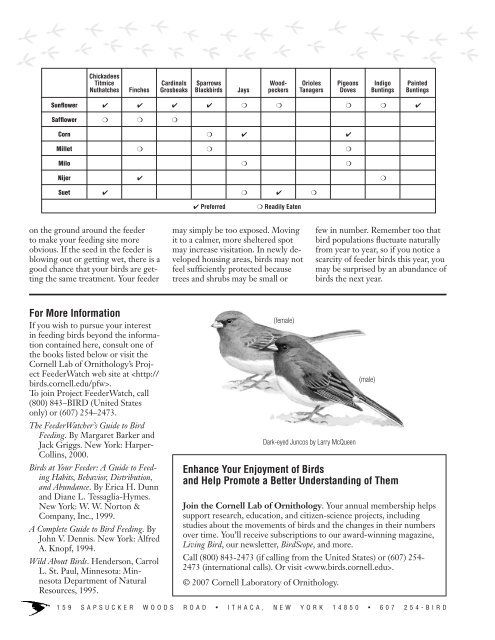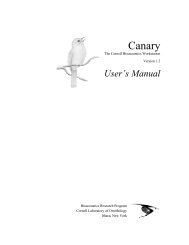WINTER BIRD FEEDING - Cornell Lab of Ornithology
WINTER BIRD FEEDING - Cornell Lab of Ornithology
WINTER BIRD FEEDING - Cornell Lab of Ornithology
You also want an ePaper? Increase the reach of your titles
YUMPU automatically turns print PDFs into web optimized ePapers that Google loves.
Chickadees<br />
Titmice Cardinals Sparrows Wood- Orioles Pigeons Indigo Painted<br />
Nuthatches Finches Grosbeaks Blackbirds Jays peckers Tanagers Doves Buntings Buntings<br />
Sunflower<br />
Safflower<br />
Corn<br />
Millet<br />
✔ ✔ ✔ ✔ ❍ ❍ ❍ ❍ ✔<br />
❍ ❍ ❍<br />
❍ ✔ ✔<br />
❍ ❍ ❍<br />
Milo<br />
❍<br />
❍<br />
Nijer<br />
Suet<br />
✔<br />
✔ ❍ ✔ ❍<br />
❍<br />
✔ Preferred<br />
❍ Readily Eaten<br />
on the ground around the feeder<br />
to make your feeding site more<br />
obvious. If the seed in the feeder is<br />
blowing out or getting wet, there is a<br />
good chance that your birds are getting<br />
the same treatment. Your feeder<br />
may simply be too exposed. Moving<br />
it to a calmer, more sheltered spot<br />
may increase visitation. In newly developed<br />
housing areas, birds may not<br />
feel sufficiently protected because<br />
trees and shrubs may be small or<br />
few in number. Remember too that<br />
bird populations fluctuate naturally<br />
from year to year, so if you notice a<br />
scarcity <strong>of</strong> feeder birds this year, you<br />
may be surprised by an abundance <strong>of</strong><br />
birds the next year.<br />
For More Information<br />
If you wish to pursue your interest<br />
in feeding birds beyond the information<br />
contained here, consult one <strong>of</strong><br />
the books listed below or visit the<br />
<strong>Cornell</strong> <strong>Lab</strong> <strong>of</strong> <strong>Ornithology</strong>’s Project<br />
FeederWatch web site at .<br />
To join Project FeederWatch, call<br />
(800) 843–<strong>BIRD</strong> (United States<br />
only) or (607) 254–2473.<br />
The FeederWatcher’s Guide to Bird<br />
Feeding. By Margaret Barker and<br />
Jack Griggs. New York: Harper-<br />
Collins, 2000.<br />
Birds at Your Feeder: A Guide to Feeding<br />
Habits, Behavior, Distribution,<br />
and Abundance. By Erica H. Dunn<br />
and Diane L. Tessaglia-Hymes.<br />
New York: W. W. Norton &<br />
Company, Inc., 1999.<br />
A Complete Guide to Bird Feeding. By<br />
John V. Dennis. New York: Alfred<br />
A. Knopf, 1994.<br />
Wild About Birds. Henderson, Carrol<br />
L. St. Paul, Minnesota: Minnesota<br />
Department <strong>of</strong> Natural<br />
Resources, 1995.<br />
(female)<br />
Dark-eyed Juncos by Larry McQueen<br />
(male)<br />
Enhance Your Enjoyment <strong>of</strong> Birds<br />
and Help Promote a Better Understanding <strong>of</strong> Them<br />
Join the <strong>Cornell</strong> <strong>Lab</strong> <strong>of</strong> <strong>Ornithology</strong>. Your annual membership helps<br />
support research, education, and citizen-science projects, including<br />
studies about the movements <strong>of</strong> birds and the changes in their numbers<br />
over time. You’ll receive subscriptions to our award-winning magazine,<br />
Living Bird, our newsletter, BirdScope, and more.<br />
Call (800) 843-2473 (if calling from the United States) or (607) 254-<br />
2473 (international calls). Or visit .<br />
© 2007 <strong>Cornell</strong> <strong>Lab</strong>oratory <strong>of</strong> <strong>Ornithology</strong>.<br />
159 Sapsucker Woods Road • Ithaca, New York 14850 • 607 254-<strong>BIRD</strong>
















